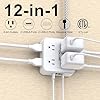Apple AirPods Pro 2 Wireless Earbuds, Active Noise Cancellation, Hearing Aid Feature, Bluetooth Headphones, Transparency, Personalized Spatial Audio, High-Fidelity Sound, H2 Chip, USB-C Charging
20% OffLactose and Tolerant Pill Holder Milk Carton Keychain backpack purse handbag (Pink)
$11.99 (as of February 18, 2025 02:04 GMT +00:00 - More infoProduct prices and availability are accurate as of the date/time indicated and are subject to change. Any price and availability information displayed on [relevant Amazon Site(s), as applicable] at the time of purchase will apply to the purchase of this product.)Deleting a folder in Python is easy if the folder is empty. You can simply use the os.rmdir() method. However, this will raise an error if the folder contains any files or subfolders.
To delete a non-empty folder recursively in Python, you need to use the shutil module. The shutil.rmtree() method will delete the entire folder tree including all subfolders and files.
In this comprehensive guide, we will cover the following topics in detail:
Overview of Deleting Folders in Python
os.rmdir()to delete an empty foldershutil.rmtree()to delete a non-empty folder- Handling errors and exceptions
- Deleting read-only files
- Concurrent file additions
- Cross-platform support
When to Use os.rmdir() vs shutil.rmtree()
- Use
os.rmdir()only when the folder is guaranteed to be empty - Use
shutil.rmtree()when the folder may contain files/subfolders rmtree()is recursive, deleting the entire folder tree
shutil.rmtree() Usage and Examples
- Import the shutil module
- Call
shutil.rmtree(path)to delete folder at path - Set
ignore_errorsparameter to handle exceptions - Use
onerrorcallback to delete read-only files
Handling Errors and Exceptions
- Catch PermissionError or OSError exceptions
- Understand error cases like read-only files
- Set
ignore_errors=Trueto delete other content - Implement
onerrorcallback to clear file permissions
Deleting Folders with Read-Only Files
- Read-only files prevent folder deletion
ignore_errors=Truedeletes all except read-only files- Implement
onerrorcallback to modify permissions - Examples for deleting folders with read-only files
Avoiding Race Conditions with Concurrent Writes
- Concurrent file additions can cause
rmtree()to fail - Use
retriesanddelayto handle race conditions - Example implementation for safe deletion with retries
Cross-Platform Support for Windows, Linux, macOS
- Use forward vs back slashes properly in file paths
- Handle drive letters and root folders for Windows
- Permissions issues on Linux and macOS
- Examples covering all major operating systems
By the end, you will have in-depth knowledge of how to robustly and safely delete folders in Python on any operating system. Let’s get started!\
Overview of Deleting Folders in Python
Before we dive into the details, let’s understand the key concepts and approaches for deleting folders in Python:
os.rmdir() to Delete an Empty Folder
The os module provides the os.rmdir(path) method to delete a folder (directory) by path.
However, rmdir() has a key limitation – it will only work if the folder is empty. If the folder contains any files or subfolders, rmdir() will raise an OSError.
Here is an example:
import os
folder = '/path/to/myfolder'
os.rmdir(folder) # Works if folder is emptySo os.rmdir() is only useful when you can guarantee the folder does not contain anything.
shutil.rmtree() to Delete a Non-Empty Folder
To delete a folder that contains files or other folders, we need to use the shutil module instead.
The shutil.rmtree(path) method will delete a folder and all its contents recursively. It is equivalent to a rm -rf path in Linux and Unix.
Here is an example of using shutil.rmtree():
import shutil
folder = '/path/to/myfolder'
shutil.rmtree(folder) # Deletes folder and all contentsAs you can see, rmtree() allows deleting the entire folder tree in one shot.
Handling Errors and Exceptions
However, deleting folders can lead to errors in certain cases:
- Folder contains read-only files
- Current user lacks permissions
- Folder contains files open by other processes
- Race conditions with concurrent file additions
To handle such errors, rmtree() provides some options:
- Set
ignore_errors=Trueto proceed deleting other contents - Provide an
onerrorcallback to handle errors gracefully
We will cover these in detail later.
Deleting Read-Only Files
On Windows, read-only files will prevent deleting the parent folder. To handle this, we need to clear the read-only flag first.
The onerror callback provides a way to modify file permissions before retrying deletion.
Avoiding Race Conditions
If concurrent processes are adding files to the folder, rmtree() may fail.
To avoid this race condition, use the retries and delay arguments to retry deletions.
Now that we understand the key concepts, let’s look at the options in more depth.
When to Use os.rmdir() vs shutil.rmtree()
The os and shutil modules provide different approaches for deleting folders in Python. To recap:
- Use
os.rmdir(path)to delete an empty folder at path - Use
shutil.rmtree(path)to delete a folder and all its contents
os.rmdir() Only for Empty Folders
The os.rmdir() method will delete a folder only if it is guaranteed empty.
For example, when deleting a temp folder that your script created and populated earlier:
import os
import tempfile
# Create temp folder
temp_dir = tempfile.mkdtemp()
# Do some processing...
# Delete temp folder
os.rmdir(temp_dir)Here you know the temp folder cannot have any content left over. So os.rmdir() is safe to use.
But if there is any chance your folder contains files or subfolders, os.rmdir() will fail with:
OSError: [Errno 39] Directory not empty: 'folder' So only use os.rmdir() when you are 100% sure the folder is empty.
shutil.rmtree() For Deleting Folder Trees
For all other cases, use shutil.rmtree(path) to delete a folder and all its contents recursively.
Some examples where rmtree() is required:
- Deleting user-specified folders which may have arbitrary content
- Deleting temp folders your script did not create
- Cleaning up nested subfolders and files
- Resetting test folders between runs
The key advantage of rmtree() is it will recursively descend into subfolders and delete the entire tree. Much more powerful than rmdir().
Now let’s look at rmtree() usage in more depth.
shutil.rmtree() Usage and Examples
The shutil module provides the rmtree() function to delete an entire folder tree recursively. Here is the signature:
shutil.rmtree(path, ignore_errors=False, onerror=None)It accepts the following parameters:
- path – Path of the folder to delete (required)
- ignore_errors – If True, errors are ignored and deletion proceeds
- onerror – Callback function called on error
Let’s see some examples of using rmtree() to delete folders in Python.
Import shutil Module
To use rmtree(), you need to import the shutil module first:
import shutilDelete Folder at Given Path
To delete a folder at a given path:
folder = '/path/to/myfolder'
shutil.rmtree(folder)This will recursively delete myfolder and all its contents.
Set ignore_errors to True
If you want deletion to proceed even if there are errors:
shutil.rmtree(folder, ignore_errors=True) This will ignore PermissionErrors and continue deleting the rest of the folder tree.
More on handling errors later.
Provide onerror Callback
To provide a callback function to handle errors:
def handle_error(func, path, exc_info):
# Check for read-only files, etc
pass
shutil.rmtree(folder, onerror=handle_error)Now that we’ve covered the basics, let’s look at handling errors.
Handling Errors and Exceptions
Deleting folders in Python using shutil.rmtree() may lead to errors in certain cases:
- Folder contains read-only files
- Insufficient permissions to delete files or folders
- Folder contains files open in another process
- Race conditions when files are modified concurrently
Thankfully, rmtree() provides some mechanisms to handle such errors gracefully:
- The
ignore_errorsparameter - Custom
onerrorcallback function
Let’s see how to use them when deleting folders.
Catching PermissionError and OSError
First, you can catch PermissionError and OSError exceptions directly when calling rmtree():
import shutil
try:
shutil.rmtree(folder)
except OSError as e:
print("Error: %s - %s." % (e.filename, e.strerror))
except PermissionError as e:
print("Permissions error: %s" % e.filename) This will handle cases where the current user does not have sufficient permissions to delete the files.
Set ignore_errors=True
To make rmtree() ignore certain errors and proceed with deleting the rest of the files in a folder:
shutil.rmtree(folder, ignore_errors=True)This will ignore PermissionErrors and delete as much content as possible.
Implement onerror Callback
However, ignore_errors will not help with all error cases like read-only files.
To handle these, you need to implement an onerror callback function:
def handle_error(func, path, exc_info):
# Check for read-only files, etc
pass
shutil.rmtree(folder, onerror=handle_error)When rmtree() encounters an error, it will call this function, allowing you to implement custom error handling like modifying file permissions.
Now let’s look specifically at deleting folders containing read-only files.
Deleting Folders with Read-Only Files
On Windows, folders containing read-only files cannot be deleted normally. The rmtree() function will fail with a PermissionError.
For example:
PermissionError: [WinError 5] Access is denied: 'readonly_file.txt' To delete folders containing read-only files, we need to:
- Set
ignore_errors=Trueto delete other contents - Implement
onerrorcallback to modify file permissions
Let’s see examples of both approaches.
ignore_errors Deletes All Except Read-only Files
Setting ignore_errors=True allows rmtree() to proceed despite errors:
shutil.rmtree(folder, ignore_errors=True)However, it will not delete the read-only files themselves. The folder will still remain, just containing only those read-only files.
So ignore_errors allows deleting all except the read-only files.
onerror Callback to Modify Permissions
To fully delete the entire folder tree including read-only files, we need to handle the PermissionError in the onerror callback.
Here is an example:
import os, stat
def remove_readonly(func, path, excinfo):
os.chmod(path, stat.S_IWRITE)
func(path)
shutil.rmtree(folder, onerror=remove_readonly)This implements a callback that:
- Changes the file permissions to writable
- Retries deletion on that file
Now rmtree() will be able to delete folders even with read-only files!
Avoiding Race Conditions with Concurrent Writes
One potential issue when deleting folders is race conditions if files are being added concurrently.
For example, consider this scenario:
- Python script calls
rmtree('/folder') - Meanwhile, another process adds a file to
/folder - Deletion fails since folder contents changed
To avoid such race conditions, rmtree() provides two parameters:
retries– Number of retries if errors are encountereddelay– Delay (in seconds) between retries
Here is an example usage:
shutil.rmtree(
folder,
ignore_errors=True,
retries=3,
delay=1
)This will retry the entire folder deletion up to 3 times, with a 1 second delay between each attempt.
This provides tolerance for concurrent write operations.
Cross-platform support for Windows, Linux, macOS
When developing cross-platform Python code for deleting folders, you need to watch out for OS-specific quirks.
Here are some tips for POSIX vs Windows systems:
Use Forward vs Backward Slashes
On Windows, use backward slashes or raw strings for paths:
folder = r'C:\path\to\folder'On POSIX systems like Linux/macOS, use forward slashes:
folder = '/home/user/folder' Or better, use OS-agnostic paths with os.path:
import os
folder = os.path.join('root','subfolder')Check for Drive Letters on Windows
On Windows, joining paths naively can strip the drive letter:
os.path.join('C:\\', 'folder') # Bad, gives \folderSo always include the drive when constructing Windows paths:
python drive = 'C:' path = os.path.join(drive, 'folder') # Good
Beware of Root Folder Deletion
Deleting folders like '/' or 'C:\\' at the root can be dangerous. Make sure to validate paths to avoid data loss.
Handle Permissions Issues on Linux/macOS
On Linux/macOS you may need sudo privileges to delete folders in restricted locations like /usr/, /System/ etc.
Handle PermissionErrors and provide instructions if admin access is required.
Summary
To summarize, deleting folders in Python requires using shutil.rmtree() for non-empty folders, along with proper error handling:
- Use
os.rmdir()only for guaranteed empty folders shutil.rmtree()deletes folder trees recursively- Set
ignore_errors=Trueto proceed on errors - Implement
onerrorcallback to handle errors like read-only files - Retry deletions to avoid race conditions from concurrent writes
- Watch out for OS-specific path issues
Following these best practices will help you robustly delete folders across platforms and avoid data loss issues.
The shutil module is quite powerful, providing many other useful file operations like copying, archiving, moving etc. I encourage you to check out the official shutil documentation further.
I hope this guide was useful in helping you master deleting folders in Python. Please feel free to provide any feedback or suggestions for improvement.





















